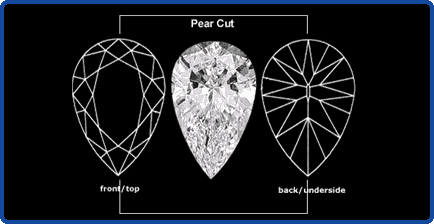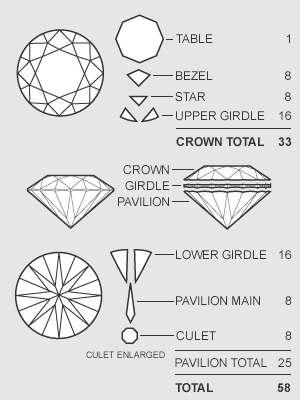About Diamond Certificates
Diamond education / certification. The two biggest laboratories in the world are GIA and EGL. Both of these are reputable with the main difference being that GIA applies a stricter grading system. Whereas the EGL approach is ‘softer’.
This may result in the same stone obtaining a different grading from the two laboratories. GIA might grade the colour of a stone as ‘H’ while EGL might grade it as ‘F/G’. Consequently, GIA might grade the clarity of a stone as ‘SI2’ while EGL might grade it as ‘VS2/SI1’.
Stone Grading
Both these laboratories grade stones according to their own master set of colour stones and clarity rules. This difference is also reflected in the price of the stone. A stone with a softer grading will carry a bigger discount than a stone with a stricter grading. Therefore, it equals out the playing field.
Grades Of Colour / Diamond Education
EGL and GIA grades colour according to the international scale of D to Z. Every letter on the scale represents a range of tone and saturation.
Two diamonds belonging to the same colour range can actually differ in their depth of colour. Since brightness and fire, which are the result of good proportions, can affect a diamond’s colour. It is important to grade a diamond not only face down but also face up. Usually as diamonds are typically set and worn face up.
In the face up position, diamonds with moderate or distinct fluorescence have a better colour than less fluorescent ones.
Colour and Clarity
Colour and clarity grading is an opinion of humans grading the stones and not an exact science. The same lab might at different times (with different employees) grade the same stone differently.
However, on the most important part of the grading report, both laboratories are exactly the same. The proportions of the diamond i.e. the table width, total depth, crown and pavilion angles etc. These are an exact science and are measured and calculated using sophisticated measuring instruments.
These proportions of the diamond determine the brilliance of the stone and therefore should be ideal. An ideal cut ‘H’ is a much better stone to buy than a poorly cut ‘F’.

This is the most common style of cutting both diamonds and coloured stones. The standard round brilliant consists of 57 facets; 1 table, 8 bezel facets, 8 star facets, 16 upper-girdle facets on the crown; 8 pavilion facets, 16 lower girdle facets; and usually a culet on the pavilion. Modifications of the round brilliant include such fancy shapes as the marquise, half moon, pear shape and many others.

The Princess
is a relatively new shape and generally has 70 to 76 facets (no culet). Normally it is close to a square shape (+ or – 10%), but may come in elongated versions. Watch out for girdles, which are extremely thin and thus prone to chipping. Typical length-to-width ratio: 1 to 1.00-1.10.

The Pear is a variation of the Brilliant cut, combining the Round and Marquise cuts, with 58 facets to only 56 facets (when the pavilion facets at the head and tail are eliminated). Shoulders should have a gently but distinctly rounded arch. Common length-to-width ratio: 1 to 1.50-1.75.

The Oval
is a brilliant style of cutting very similar to a Round except it is elliptical, and was invented by Lazare Kaplan in the early 1960s.
Oval brilliant usually has 56 or 57 facets. Beware of uneven or high shoulders (they should have a gently but distinctly rounded arch). Typical length-to-width ratio: 1 to 1.30-1.65.

Marquise
This shape has a boat shaped girdle with 57 facets. The shape and placement of the facets is of the brilliant type. The name ‘Marquise’ came from a legend of the Marquise of Pompadour that the Sun King wanted a Diamond to be polished into the shape of the mouth of the Marquise.
Look for uneven ‘wings’ or undefined points. Typical length-to-width ratio: 1 to 1.75-2.25.

The Emerald
is a form of step cutting. It is usually rectangular but sometimes may be square, in which case it is known as a square emerald cut. It has rows (steps) of elongated facets on the crown and pavilion, parallel to the girdle, and with corner facets. The number of rows of elongated facets may vary, although the usual number is three on the crown and three on the pavilion
Inclusions are slightly more visible in ‘step-cut’ shapes relative to ‘brilliant’ styles. Look for too narrow or missing corners. The bevelled corners protect the stone and make it easier to set. Typical length-to-width ratio: 1 to 1.30-1.70.

This is a rectangular or square stone with cut corners. The original patented cut has 70 facets but it is readily available in modified versions with 62 to 70 facets. Typical length-to-width ratio: 1 to 1.20-1.50 for the rectangular stones.

The heart
Look for uneven or flat ‘wings’ or too shallow cleft. Typical length-to-width ratio: 1 to 0.90-1.10.

Trillion
is a popular choice for side-diamonds to enhance a centre diamond. Typical length-to-width ratio: 1 to 0.90-1.10.
The Cushion
evolved from the ‘Old Mine Cut’ that was developed before the turn of the century. It is a square to rectangular cut with rounded corners and 58 facets and is characterised by large facets, depth, and an open cutlet (the tip on the bottom of the diamond).
What determines the value of a diamond?
There are four main factors that determine the value of a diamond. They are referred to as the Four C’s:
How to estimate the weight of a diamond




